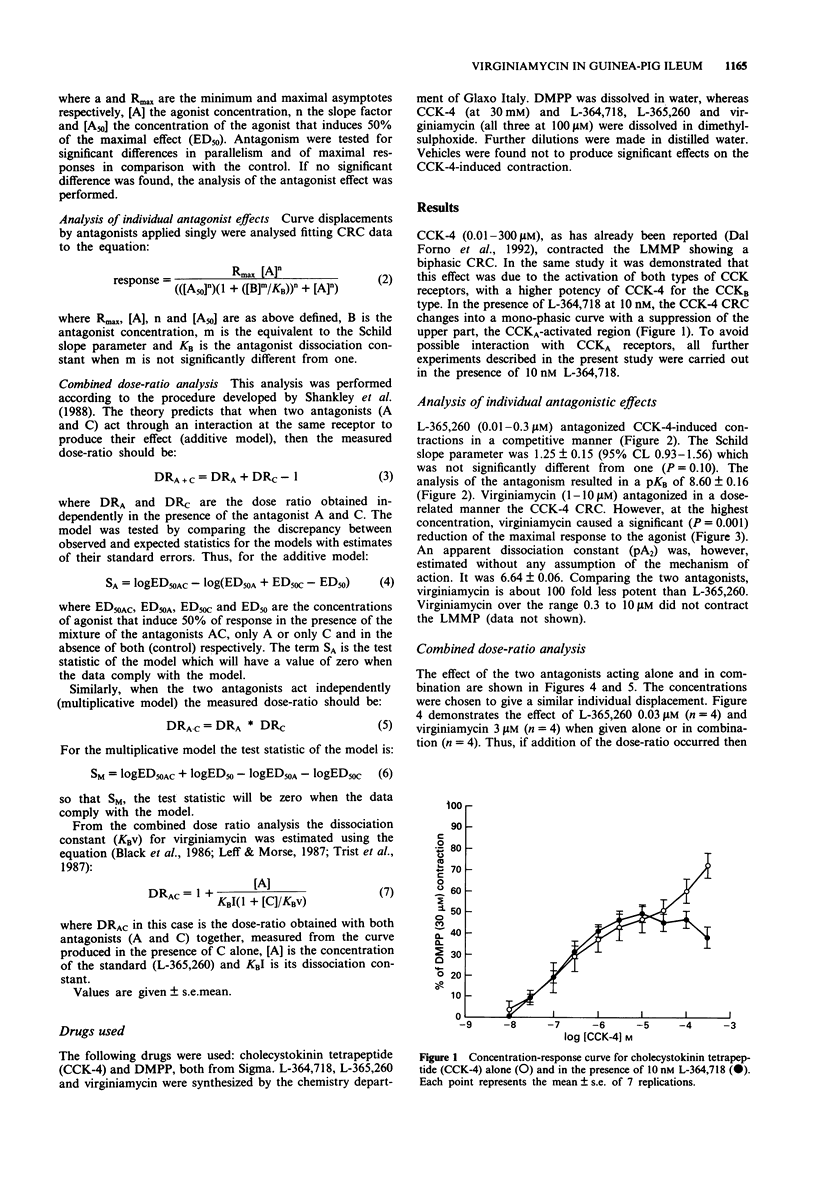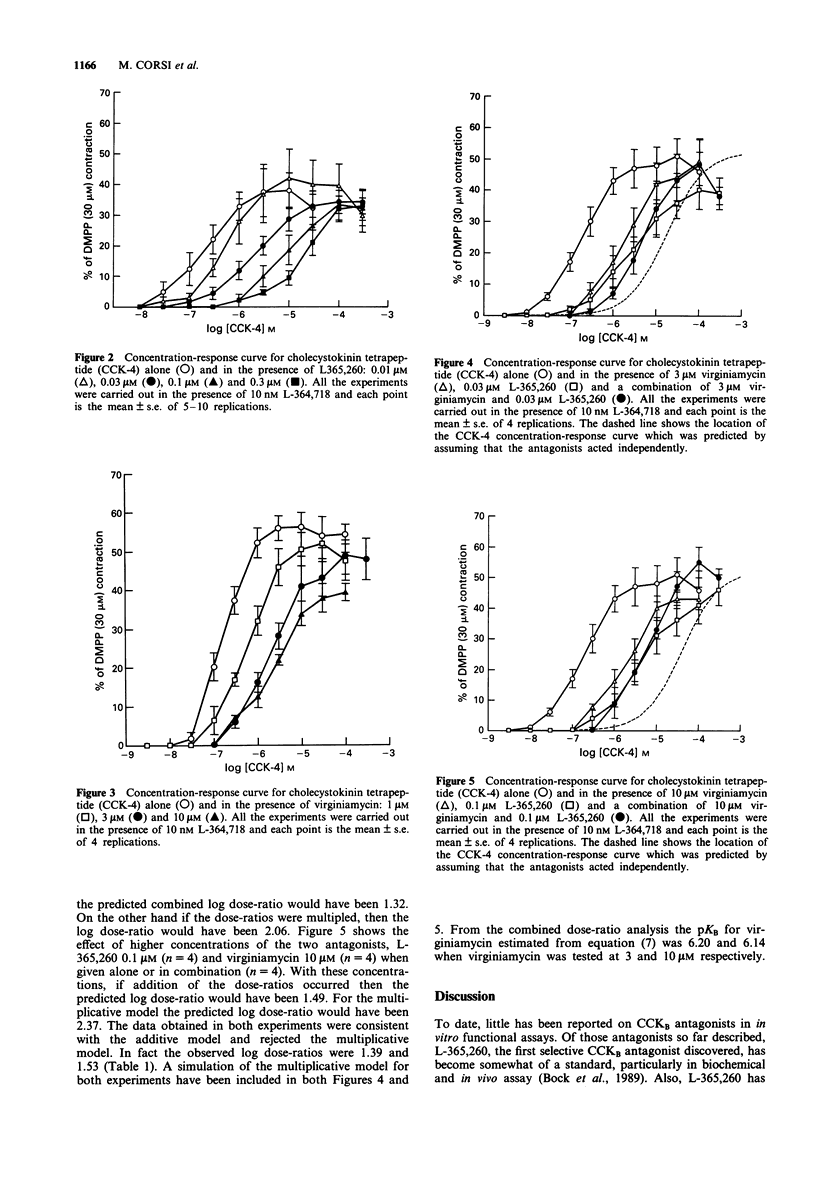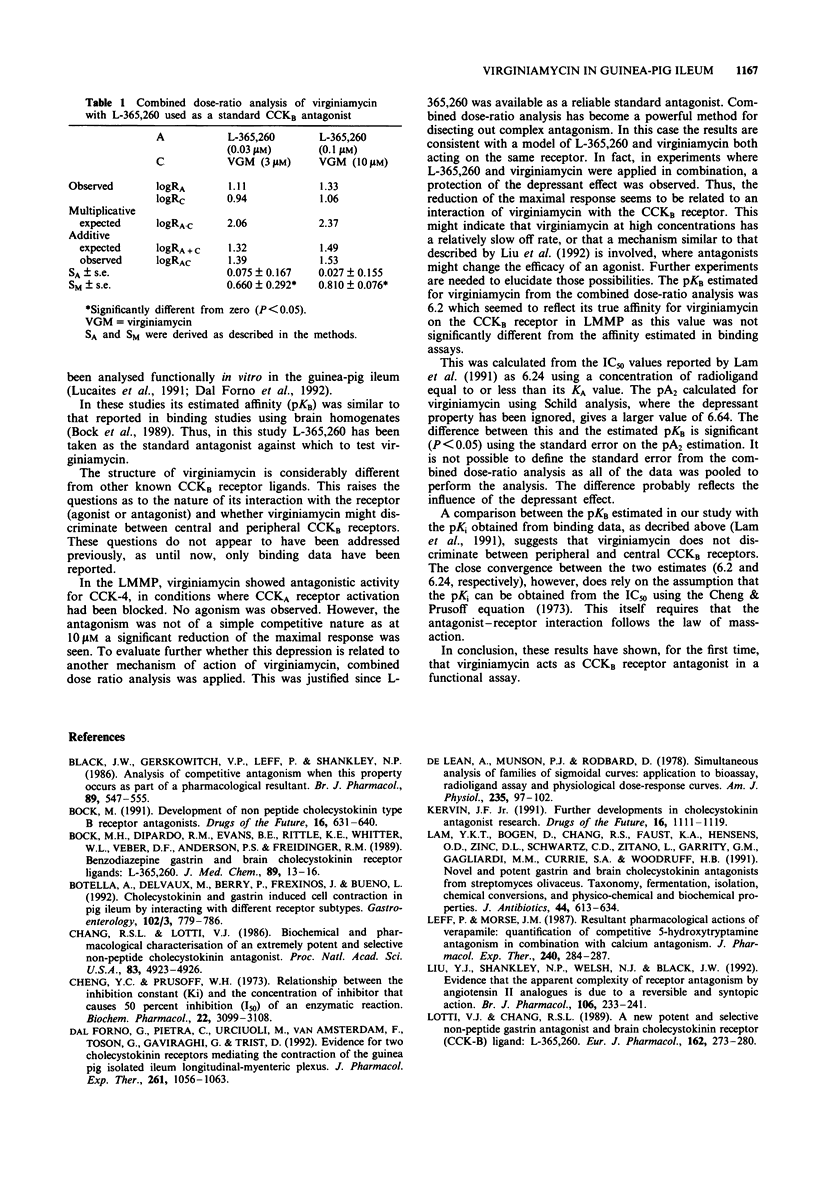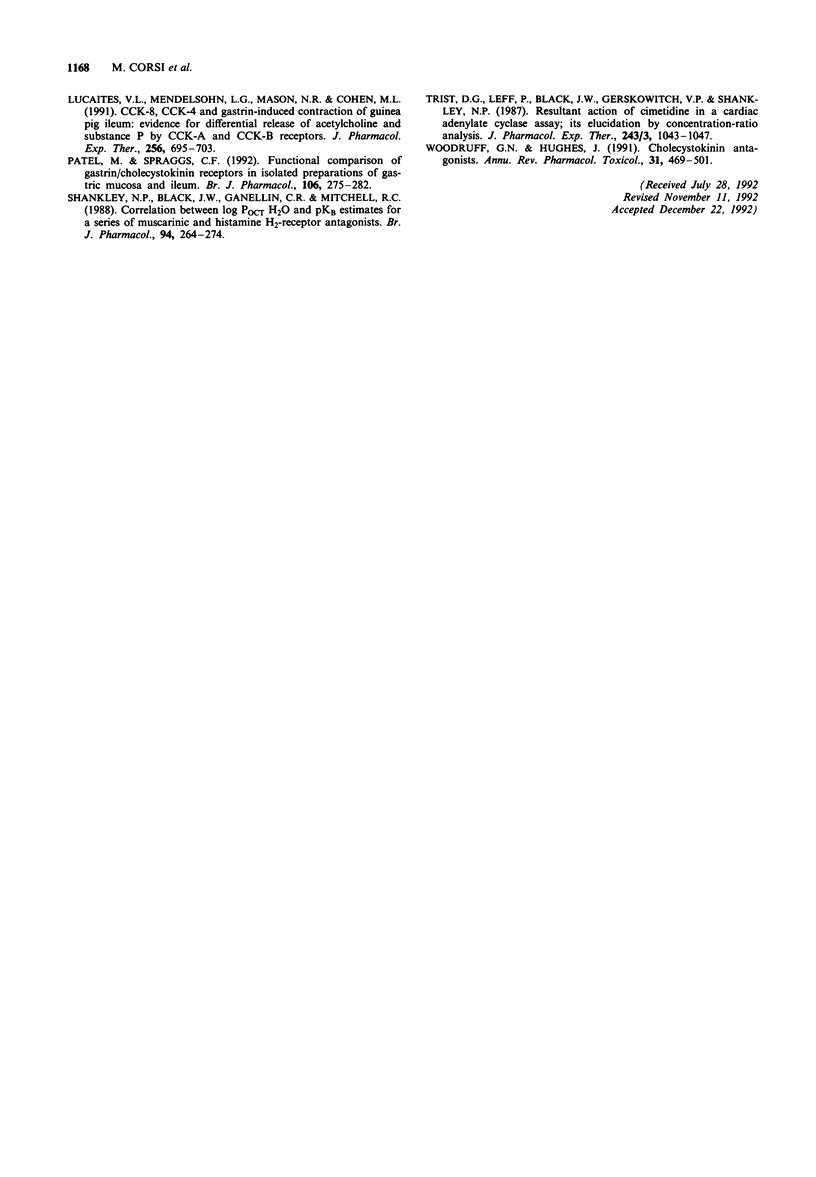Abstract
1. Virginiamycin, a macrolide reported to bind selectively to CCKB/gastrin receptors has been studied in a functional test, namely cholecystokinin-induced contraction of guinea-pig ileum myenteric plexus (LMMP). 2. Virginiamycin (1-10 microM) antagonized the selective CCKB agonist cholecystokinin tetrapeptide (CCK-4). The antagonism appeared not to be competitive as the highest concentration (10 microM) caused a reduction of its maximal effect. An apparent pA2 of 6.64 +/- 0.06 (s.e.) could be estimated if this depression was ignored. The selective CCKB antagonist, L-365,260 (0.01-0.3 microM) antagonized competitively the CCK-4 induced contraction and a pKB of 8.60 +/- 0.16 (s.e.) was estimated. 3. The combined dose-ratio analysis for virginiamycin, tested at 3 and 10 microM in association with 0.03 and 0.1 microM L-365,260, respectively, resulted in observed log dose-ratios of 1.39 and 1.53. That was consistent with both antagonists acting on the same receptor in LMMP. 4. These data, represent the first evidence of the antagonism of virginiamycin in a functional assay and they support the hypothesis of homogeneity between CCKB receptors in the CNS and in peripheral tissues.
Full text
PDF




Selected References
These references are in PubMed. This may not be the complete list of references from this article.
- Black J. W., Gerskowitch V. P., Leff P., Shankley N. P. Analysis of competitive antagonism when this property occurs as part of a pharmacological resultant. Br J Pharmacol. 1986 Nov;89(3):547–555. doi: 10.1111/j.1476-5381.1986.tb11155.x. [DOI] [PMC free article] [PubMed] [Google Scholar]
- Bock M. G., DiPardo R. M., Evans B. E., Rittle K. E., Whitter W. L., Veber D. E., Anderson P. S., Freidinger R. M. Benzodiazepine gastrin and brain cholecystokinin receptor ligands: L-365,260. J Med Chem. 1989 Jan;32(1):13–16. doi: 10.1021/jm00121a004. [DOI] [PubMed] [Google Scholar]
- Botella A., Delvaux M., Berry P., Frexinos J., Bueno L. Cholecystokinin and gastrin induce cell contraction in pig ileum by interacting with different receptor subtypes. Gastroenterology. 1992 Mar;102(3):779–786. doi: 10.1016/0016-5085(92)90158-u. [DOI] [PubMed] [Google Scholar]
- Chang R. S., Lotti V. J. Biochemical and pharmacological characterization of an extremely potent and selective nonpeptide cholecystokinin antagonist. Proc Natl Acad Sci U S A. 1986 Jul;83(13):4923–4926. doi: 10.1073/pnas.83.13.4923. [DOI] [PMC free article] [PubMed] [Google Scholar]
- Cheng Y., Prusoff W. H. Relationship between the inhibition constant (K1) and the concentration of inhibitor which causes 50 per cent inhibition (I50) of an enzymatic reaction. Biochem Pharmacol. 1973 Dec 1;22(23):3099–3108. doi: 10.1016/0006-2952(73)90196-2. [DOI] [PubMed] [Google Scholar]
- Dal Forno G., Pietra C., Urciuoli M., van Amsterdam F. T., Toson G., Gaviraghi G., Trist D. Evidence for two cholecystokinin receptors mediating the contraction of the guinea pig isolated ileum longitudinal muscle myenteric plexus. J Pharmacol Exp Ther. 1992 Jun;261(3):1056–1063. [PubMed] [Google Scholar]
- DeLean A., Munson P. J., Rodbard D. Simultaneous analysis of families of sigmoidal curves: application to bioassay, radioligand assay, and physiological dose-response curves. Am J Physiol. 1978 Aug;235(2):E97–102. doi: 10.1152/ajpendo.1978.235.2.E97. [DOI] [PubMed] [Google Scholar]
- Lam Y. K., Bogen D., Chang R. S., Faust K. A., Hensens O. D., Zink D. L., Schwartz C. D., Zitano L., Garrity G. M., Gagliardi M. M. Novel and potent gastrin and brain cholecystokinin antagonists from Streptomyces olivaceus. Taxonomy, fermentation, isolation, chemical conversions, and physico-chemical and biochemical properties. J Antibiot (Tokyo) 1991 Jun;44(6):613–625. doi: 10.7164/antibiotics.44.613. [DOI] [PubMed] [Google Scholar]
- Leff P., Morse J. M. Resultant pharmacological actions of verapamil: quantification of competitive 5-hydroxytryptamine antagonism in combination with calcium antagonism. J Pharmacol Exp Ther. 1987 Jan;240(1):284–287. [PubMed] [Google Scholar]
- Liu Y. J., Shankley N. P., Welsh N. J., Black J. W. Evidence that the apparent complexity of receptor antagonism by angiotensin II analogues is due to a reversible and syntopic action. Br J Pharmacol. 1992 Jun;106(2):233–241. doi: 10.1111/j.1476-5381.1992.tb14322.x. [DOI] [PMC free article] [PubMed] [Google Scholar]
- Lotti V. J., Chang R. S. A new potent and selective non-peptide gastrin antagonist and brain cholecystokinin receptor (CCK-B) ligand: L-365,260. Eur J Pharmacol. 1989 Mar 21;162(2):273–280. doi: 10.1016/0014-2999(89)90290-2. [DOI] [PubMed] [Google Scholar]
- Lucaites V. L., Mendelsohn L. G., Mason N. R., Cohen M. L. CCK-8, CCK-4 and gastrin-induced contractions in guinea pig ileum: evidence for differential release of acetylcholine and substance P by CCK-A and CCK-B receptors. J Pharmacol Exp Ther. 1991 Feb;256(2):695–703. [PubMed] [Google Scholar]
- Patel M., Spraggs C. F. Functional comparisons of gastrin/cholecystokinin receptors in isolated preparations of gastric mucosa and ileum. Br J Pharmacol. 1992 Jun;106(2):275–282. doi: 10.1111/j.1476-5381.1992.tb14328.x. [DOI] [PMC free article] [PubMed] [Google Scholar]
- Shankley N. P., Black J. W., Ganellin C. R., Mitchell R. C. Correlation between log POCT/H2O and pKB estimates for a series of muscarinic and histamine H2-receptor antagonists. Br J Pharmacol. 1988 May;94(1):264–274. doi: 10.1111/j.1476-5381.1988.tb11523.x. [DOI] [PMC free article] [PubMed] [Google Scholar]
- Trist D. G., Leff P., Black J., Gerskowitch V. P., Shankley N. P. Resultant action of cimetidine in a cardiac adenylate cyclase assay: its elucidation by concentration-ratios analysis. J Pharmacol Exp Ther. 1987 Dec;243(3):1043–1047. [PubMed] [Google Scholar]
- Woodruff G. N., Hughes J. Cholecystokinin antagonists. Annu Rev Pharmacol Toxicol. 1991;31:469–501. doi: 10.1146/annurev.pa.31.040191.002345. [DOI] [PubMed] [Google Scholar]


